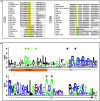Coreceptors and TCR Signaling - the Strong and the Weak of It
- PMID: 33178706
- PMCID: PMC7596257
- DOI: 10.3389/fcell.2020.597627
Coreceptors and TCR Signaling - the Strong and the Weak of It
Abstract
The T-cell coreceptors CD4 and CD8 have well-characterized and essential roles in thymic development, but how they contribute to immune responses in the periphery is unclear. Coreceptors strengthen T-cell responses by many orders of magnitude - beyond a million-fold according to some estimates - but the mechanisms underlying these effects are still debated. T-cell receptor (TCR) triggering is initiated by the binding of the TCR to peptide-loaded major histocompatibility complex (pMHC) molecules on the surfaces of other cells. CD4 and CD8 are the only T-cell proteins that bind to the same pMHC ligand as the TCR, and can directly associate with the TCR-phosphorylating kinase Lck. At least three mechanisms have been proposed to explain how coreceptors so profoundly amplify TCR signaling: (1) the Lck recruitment model and (2) the pseudodimer model, both invoked to explain receptor triggering per se, and (3) two-step coreceptor recruitment to partially triggered TCRs leading to signal amplification. More recently it has been suggested that, in addition to initiating or augmenting TCR signaling, coreceptors effect antigen discrimination. But how can any of this be reconciled with TCR signaling occurring in the absence of CD4 or CD8, and with their interactions with pMHC being among the weakest specific protein-protein interactions ever described? Here, we review each theory of coreceptor function in light of the latest structural, biochemical, and functional data. We conclude that the oldest ideas are probably still the best, i.e., that their weak binding to MHC proteins and efficient association with Lck allow coreceptors to amplify weak incipient triggering of the TCR, without comprising TCR specificity.
Keywords: CD4; CD8; T-cell signaling; TCR triggering; antigen discrimination.
Copyright © 2020 Mørch, Bálint, Santos, Davis and Dustin.
Figures



Similar articles
-
The kinase occupancy of T cell coreceptors reconsidered.Proc Natl Acad Sci U S A. 2022 Dec 6;119(49):e2213538119. doi: 10.1073/pnas.2213538119. Epub 2022 Dec 1. Proc Natl Acad Sci U S A. 2022. PMID: 36454761 Free PMC article.
-
Association of the adaptor molecule LAT with CD4 and CD8 coreceptors identifies a new coreceptor function in T cell receptor signal transduction.J Exp Med. 1999 Nov 15;190(10):1517-26. doi: 10.1084/jem.190.10.1517. J Exp Med. 1999. PMID: 10562325 Free PMC article.
-
Structural and biophysical insights into the role of CD4 and CD8 in T cell activation.Front Immunol. 2013 Jul 22;4:206. doi: 10.3389/fimmu.2013.00206. eCollection 2013. Front Immunol. 2013. PMID: 23885256 Free PMC article.
-
Thymic Origins of T Cell Receptor Alloreactivity.Transplantation. 2017 Jul;101(7):1535-1541. doi: 10.1097/TP.0000000000001654. Transplantation. 2017. PMID: 28114168 Review.
-
Dual Role of CD4 in Peripheral T Lymphocytes.Front Immunol. 2019 Apr 2;10:618. doi: 10.3389/fimmu.2019.00618. eCollection 2019. Front Immunol. 2019. PMID: 31001252 Free PMC article. Review.
Cited by
-
TCR-NK Cells: A Novel Source for Adoptive Immunotherapy of Cancer.Turk J Haematol. 2023 Feb 28;40(1):1-10. doi: 10.4274/tjh.galenos.2022.2022.0534. Epub 2023 Jan 31. Turk J Haematol. 2023. PMID: 36719099 Free PMC article. Review.
-
Modulation of Lymphocyte Functions in the Microenvironment by Tumor Oncogenic Pathways.Front Immunol. 2022 May 19;13:883639. doi: 10.3389/fimmu.2022.883639. eCollection 2022. Front Immunol. 2022. PMID: 35663987 Free PMC article. Review.
-
Comprehensive epitope mutational scan database enables accurate T cell receptor cross-reactivity prediction.bioRxiv [Preprint]. 2025 Feb 21:2024.01.22.576714. doi: 10.1101/2024.01.22.576714. bioRxiv. 2025. Update in: Cell Syst. 2025 Jul 23:101345. doi: 10.1016/j.cels.2025.101345. PMID: 38370810 Free PMC article. Updated. Preprint.
-
Discordant CAR-T cell signaling: implications of divergence from physiological T cell activation.J Transl Med. 2025 Jul 25;23(1):834. doi: 10.1186/s12967-025-06857-w. J Transl Med. 2025. PMID: 40713606 Free PMC article. Review.
-
Biomaterials-mediated ligation of immune cell surface receptors for immunoengineering.Immunooncol Technol. 2023 Dec 10;21:100695. doi: 10.1016/j.iotech.2023.100695. eCollection 2024 Mar. Immunooncol Technol. 2023. PMID: 38405432 Free PMC article. Review.
References
Publication types
Grants and funding
LinkOut - more resources
Full Text Sources
Research Materials
Miscellaneous

